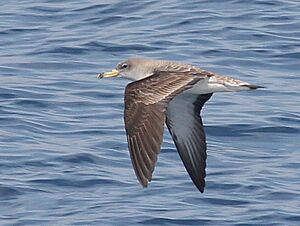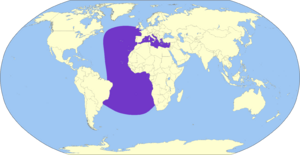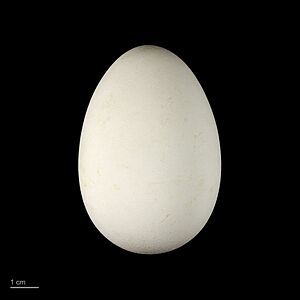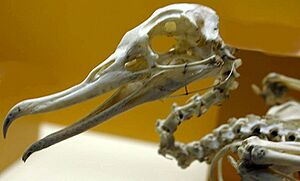Scopoli's shearwater facts for kids
Quick facts for kids Scopoli's shearwater |
|
|---|---|
 |
|
| Conservation status | |
| Scientific classification | |
 |
The Scopoli's shearwater (scientific name: Calonectris diomedea) is a type of seabird. It belongs to the petrel family, called Procellariidae. These birds make their nests on rocky islands and steep coastlines around the Mediterranean Sea. When they are not breeding, they fly to the Atlantic Ocean to find food. Scopoli's shearwaters are brownish-grey on top with darker wings. Their undersides are mostly white. They have a pale yellow beak with a dark spot near the end. Males and females look very similar. This bird was once thought to be the same species as Cory's shearwater.
Contents
Understanding Scopoli's Shearwater Names
The Scopoli's shearwater was first officially described in 1769. This was done by an Austrian scientist named Giovanni Antonio Scopoli. He put this bird in the same group as other petrels, which was called Procellaria. He gave it the two-part scientific name Procellaria diomedea.
Scopoli did not say exactly where he found the first bird. But in 1946, a group of British bird experts decided it was from the Tremiti Islands. These islands are in the Adriatic Sea.
Today, Scopoli's shearwater is in a different group, or genus, called Calonectris. This name was created in 1915. The word kalos in Ancient Greek means "good" or "noble." Nectris comes from an old Greek word meaning "swimmer." The second part of the name, diomedea, refers to a hero from Greek mythology named Diomedes. Legend says his friends turned into white seabirds after he died. This bird is considered a single species, meaning it has no different types or subspecies.
How Scopoli's Shearwater is Different from Cory's
Scopoli's shearwater and Cory's shearwater were once thought to be the same species. They were called the Cory's shearwater complex. But scientists found differences between them. They looked at their DNA, how they looked, and the sounds they made. They also saw that these birds did not mix and have babies together. Because of these differences, they were split into two separate species. The name "Cory's shearwater" now refers to Calonectris borealis. What was once part of that group became Scopoli's shearwater (Calonectris diomedea).
What Scopoli's Shearwater Looks Like
Scopoli's shearwater is about 45 to 52 centimeters (18 to 20 inches) long. Its wings can spread out 112 to 122 centimeters (44 to 48 inches) wide. The top part of its body is brownish-grey. Most of its feathers have lighter brown edges. Its wings are a darker brown color. The feathers on its upper tail are tipped with white, and its tail is dark brown.
The underside of the bird is mostly white. It has a brown edge, which is easiest to see on the back edge of its wings. Its beak is pale yellow with a dark spot near the tip. Its legs and feet are a pale flesh color. Male and female birds look similar. However, males are usually a little bigger than females.
Telling Them Apart from Other Birds
It can be hard to tell Scopoli's shearwater apart from Cory's shearwater. One way to tell them apart is by looking at the underside of their wings. Scopoli's shearwater has more white on the main flight feathers at the wingtip. This is especially true for the outermost large feather. The Cape Verde shearwater is smaller than Scopoli's shearwater. It also has much darker feathers on its upper body.
Where Scopoli's Shearwater Lives and Travels
Scopoli's shearwaters nest on islands in the Mediterranean Sea. They can be found from the Chafarinas Islands near Morocco in the west. They also live as far east as the Dodecanese islands near Turkey.
The biggest group of these birds lives on the rocky island of Zembra. This island is about 13 kilometers (8 miles) off the coast of Tunisia. This colony has between 141,000 and 223,000 breeding pairs. This is more than 75 percent of all Scopoli's shearwaters in the world. Other large groups are found on the island of Linosa in the Strait of Sicily. They also live on the Balearic Islands.
Their Amazing Migration Journey
At the end of October, after the breeding season, Scopoli's shearwaters fly away. They migrate to the Atlantic Ocean. They leave the Mediterranean Sea by flying through the Strait of Gibraltar. They return to the Mediterranean at the end of February.
Scientists have used small tracking devices to follow these birds. They found that birds from Linosa or the Pantaleu islet in the Balearic Islands spent their winter in the southeastern Atlantic. They went to areas where deep ocean water rises to the surface. This brings up lots of food. Some birds looked for food off the coast of West Africa. This area has an ocean current called the Canary Current. Other birds flew even further south. They found food in the Benguela Current off the coast of Namibia.
What Scopoli's Shearwater Eats
Scopoli's shearwater mostly eats small fish. But they also eat cephalopods (like squid and octopus) and crustaceans (like crabs and shrimp). They find food by skimming over the water's surface. They also feed right on the surface. They only dive completely underwater very rarely.
Sometimes, these birds follow whales and tuna. They do this to pick up leftover food scraps. They also catch small fish that the whales and tuna have pushed to the surface. Scopoli's shearwaters will also eat food that fishing boats throw away.




